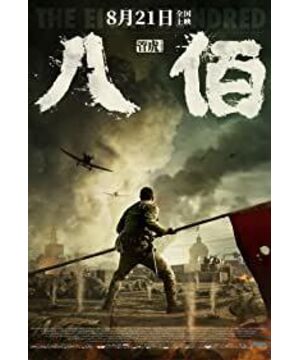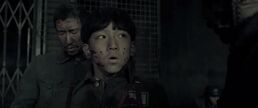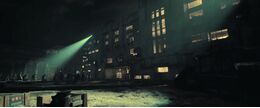Basically, boys born in the 1960s are particularly interested in war movies. China's modern history is a history of being bullied and enslaved. Therefore, some war movies that exaggerate the courage to kill the enemy and serve the country with blood have become the external manifestation of the patriotic spirit of resisting aggression and oppression, and its patriotic spirit will also penetrate into the construction of an individual's personality. When watching "Eight Hundred", you will usually notice that the first shot is of a mouse coming out of a hole and shrinking back. Animal characters such as mice and white horses also appear in the Sixing warehouse. This is also a metaphor that cannot be ignored. For many ordinary people to avoid it, the Chinese live like rats, and they are forced out of the light of human nature after experiencing the humiliation of the enemy.
At the beginning, countless peasant soldiers gathered from all over the country showed a scattered state of flight. They were forced to rush from the boundless paddy fields to the city purgatory destroyed by artillery fire. At this moment, the scorched black body of a mud statue with crows resting on the corpse and the broken walls of the plane wreckage have forced out the tragic and suffocating feeling of the war. Butcher knife, in a blink of an eye, has become the ghost of the Kuomintang supervising team. War is such an incredible thing, as if the running people did not notice the ants around them. People are like ants, and their lives are worthless. The uncertainty of the battlefield often makes it difficult. Unexpected death came suddenly.
The sacrifice of the eight hundred warriors like moths to the flames is not only a pawn of political interests, a myth of national dignity, but also a torture of human nature. The Japanese soldiers hung Chinese prisoners of war on poles, stabbed them to death with bayonets, and threatened the Chinese defenders of the Sixing Warehouse to surrender. The Japanese prisoners of war who survived the war and the poison gas attack were caught to practice targets. The soldiers were like mice forced out of their caves. They evolved into demons under the special circumstances of either your death or my death. Some people resisted, Anger, as well as calm and precise kills, not only avenge the murdered brothers, but also inspire the courage of recruits (Dragon Boat Festival) to kill.
What is impressive is the mental outlook that distinguishes the national army, the Japanese army and ordinary people. The Japanese army first appeared in the blurred vision of the Dragon Boat Festival. The Japanese were still the Japanese death squads that swam in with bayonets in their mouths. They were in a state of ferocity as a whole, which was a powerful external pressure, causing the Chinese to become devils in order to fight against them. The Chinese look like a group of skirmishers, but they are actually commanded in an orderly manner. They are a group of trapped beasts. They become unknown heroes under the camera of Fang reporter. Before the sacrifice, the cameras were used to preserve their spiritual appearance. It is a pity that the cameras that recorded the most important moments of the soldiers' lives fell during the retreat. In fact, the moving images of the Sixing Warehouse are rarely preserved until now, which seems to imply that because of history The lack of footage, the situation that happened in that battle has gradually disappeared from the memory of modern people.
The structure of the play on stage and viewing enables some important viewpoints to observe the dangerous situation of the brave men on the north bank from the perspective of the masses on the south bank, such as the reporter Fang from the Japanese barracks, the international observers on the airship, the foreigners eating bread and setting up cameras, The university professors holding binoculars in the building, the students of the opera troupe, and the ordinary people gathered on the shore use different viewing distances to simulate their viewpoints. The camera was mobilized with a very open stand-alone camera. Before the stage of the Sixing Warehouse was set up, the focus of the lens was scattered in the scattered group portraits, and the background sound was very vague, which increased the sense of distance between the audience and the point of view of individual life. After the battle, the camera and the soldiers fighting hard, the moment of the explosion and the bullets that penetrated the human body are getting closer and closer, and the public is slowly infiltrated into a sense of participation from such a bystander's point of view, showing the people's feelings towards the soldiers. Their mentality changed from being indifferent and applauding to reaching out for help. The attitude of the people on the South Bank on the first day was to exist as numb bystanders, watching the ships firing artillery fire on the water surface, and the Japanese soldiers surrounding the North Bank standing in a dense row on the high-rise building, pulling the sun flag and cheering, showing off their might, while they watched the fire from the other side, the plaque behind the stage There are monkey players, prostitutes soliciting business, and chaotic refugees to collect supplies distributed by the Boy Scouts. Indifferent spectators shuttled through the crowd and wrote the odds of the battle on the flag, as if they were sitting under the stage. Like the audience, the arrogance of the invaders was suppressed on the second day. When the audience was large, the response was enthusiastic, and their patriotism was ignited. After that, the flag was raised to pay tribute. Although the actors stood still, the camera took subjective emotions. Intense shoulder-to-shoulder shooting, you can personally feel the immersion in patriotism in the heart, and finally accompanied by the flares emitting the brightest light in the night sky, the people on the south bank and the strong men on the north bank, from a state of dispersion, nothing to do with themselves, to unity. , to achieve the expected effect of national identity and nation-building on the narrative theme.
The color matching fully guides the audience at the level of emotional experience. The colors of the neon lights on the south bank vary, and the night scene lights representing a peaceful state are particularly bright, mixed with a large area of red with a sense of magic, and the flickering of the lights is reflected on the windows of the building on the north bank. On the glass, a strange contradiction is formed with the darkness in the Sixing warehouse. Light represents awakening, hope and the imagination of beauty. When Xiaohu wanted to look at the white horse that symbolized hope, he was shot by a gun. However, he looked at the bright lights on the other side from the window, and there was turmoil between life and death. The atmosphere of light and hope can be felt again in the environment, and the light also dispels the ignorant and dark Chinese nationality.
"Eight Hundred" creates a balance between freehand brushwork, beauty and cruelty and darkness in the image narrative, substituting the audience into a highly realistic historical scene, but the text narrative is not complete, the film focuses on various human nature in war The performance of the state, in addition to restoring the overall atmosphere of the war, also has to deal with more complex and far-reaching political issues. There is more than enough power, and the freehand interspersed animal characters, cultural symbols of Peking Opera and movies, and even directly used Zhao Zilong's poetry of charging alone. The scene is separated from the overall atmosphere that emphasizes blood and reality, and such a story tells the story of soldiers protecting the country and the people, and what really provides them with protection is the international forces represented by the Nazi flag, the red cross and the Union Jack, which leads to the sublimation of the theme. The above is deliberately exaggerated, but Guan Hu's desire to express and the excellence of the production staff are still worthy of recognition.
View more about The Eight Hundred reviews











